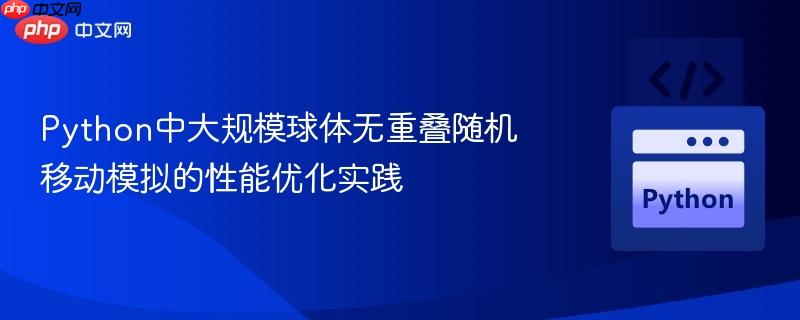
在物理模拟、图形学或科学计算等领域,经常需要模拟大量粒子或物体(如球体)的随机运动,同时要确保它们之间不发生重叠,并遵守特定的空间边界条件。当球体数量达到百万级别时,这种模拟的计算成本会急剧增加,尤其是在处理碰撞检测(即重叠检查)时。
一个常见的初始实现思路是:
在Python中,如果直接按照上述逻辑逐个球体进行操作,并使用scipy.spatial.cKDTree进行近邻查询,但每次移动一个球体就重建或重复查询KDTree,会导致严重的性能问题。尤其当球体数量巨大时,这种逐点处理和频繁的KDTree操作会使得模拟速度变得异常缓慢。
初始实现的主要性能瓶颈:
为了显著提升大规模球体随机运动模拟的性能,可以从以下几个方面进行优化:
立即学习“Python免费学习笔记(深入)”;
scipy.spatial.cKDTree是一个高度优化的数据结构,用于高效地执行近邻搜索。其query_ball_point()方法不仅可以查询单个点,还可以接受一个点数组进行批处理查询。利用这一点可以大幅减少KDTree的查询开销。
优化点:
cKDTree的query_ball_point()方法支持多核并行计算,通过设置workers=-1参数,可以使其尽可能利用所有可用的CPU核心,进一步加速近邻查询过程。
优化点:
Numba是一个开源的JIT(Just-In-Time)编译器,可以将Python和NumPy代码编译成快速的机器码。对于计算密集型的函数,尤其是涉及循环和数值运算的部分,使用Numba的@nb.njit()装饰器可以带来显著的性能提升。
优化点:
Numba优化细节:
下面是结合上述优化策略后的Python代码实现。
import numpy as np
from scipy.spatial import cKDTree
import numba as nb
import math
# 假设Rmax, Zmin, Zmax是全局变量或通过参数传入
# 为了演示,这里定义一些示例值
Rmax = 100.0
Zmin = -50.0
Zmax = 50.0
@nb.njit()
def in_cylinder(point, Rmax_sq, Zmin, Zmax):
"""
检查一个点是否在圆柱体内。
使用Rmax_sq (Rmax的平方) 避免不必要的平方根计算。
point: 单个点的坐标数组 [x, y, z]
"""
# 径向距离的平方
radial_distance_sq = point[0]**2 + point[1]**2
return (radial_distance_sq <= Rmax_sq) & \
(Zmin <= point[2]) & (point[2] <= Zmax)
@nb.njit()
def generate_random_vector(max_magnitude):
"""
生成一个随机方向和随机大小的3D向量。
"""
# 生成一个随机方向向量
direction = np.random.randn(3)
direction_norm = np.linalg.norm(direction)
# 避免除以零
if direction_norm == 0:
direction = np.array([1.0, 0.0, 0.0]) # 默认方向
else:
direction /= direction_norm
# 生成一个随机大小
magnitude = np.random.uniform(0, max_magnitude)
return direction * magnitude
@nb.njit()
def euclidean_distance(vec_a, vec_b):
"""
计算两个3D向量之间的欧几里得距离。
"""
acc = 0.0
for i in range(vec_a.shape[0]):
acc += (vec_a[i] - vec_b[i]) ** 2
return math.sqrt(acc)
@nb.njit()
def any_neighbor_in_range(new_center, all_centers, neighbors_indices, threshold, ignore_idx):
"""
检查新球体中心是否与任何潜在邻居重叠。
all_centers: 所有球体的中心点数组
neighbors_indices: 潜在邻居的索引列表
threshold: 距离阈值 (2 * r_spheres)
ignore_idx: 当前移动球体的索引,避免与自身比较
"""
for neighbor_idx in neighbors_indices:
if neighbor_idx == ignore_idx:
# 忽略自身
continue
distance = euclidean_distance(new_center, all_centers[neighbor_idx])
if distance < threshold:
return True # 发现重叠
return False # 没有重叠
def move_spheres_optimized(centers, r_spheres, motion_coef, N_motions):
"""
优化后的球体随机移动函数。
centers: 初始球体中心点数组 (N, 3)
r_spheres: 球体半径
motion_coef: 运动系数,用于计算最大移动距离
N_motions: 模拟的总步数
"""
n_spheres = len(centers)
updated_centers = np.copy(centers)
motion_magnitude = motion_coef * r_spheres
overlap_threshold = 2 * r_spheres # 两个球体不重叠的最小距离
Rmax_sq = Rmax ** 2 # 预计算Rmax的平方
for motion_step in range(N_motions):
# 每步重新构建KDTree,因为球体位置可能发生变化
# 使用updated_centers构建KDTree
tree = cKDTree(updated_centers)
# 批处理查询所有球体的潜在邻居,利用多核并行
# 查询半径为 2*r_spheres + 2*motion_magnitude,这是最大可能重叠的范围
potential_neighbors_batch = tree.query_ball_point(
updated_centers,
overlap_threshold + 2 * motion_magnitude, # 考虑最大移动距离后的潜在邻居范围
workers=-1 # 利用所有可用CPU核心
)
updated_count = 0
for i in range(n_spheres):
# 生成随机移动向量
vector = generate_random_vector(motion_magnitude)
# 预测新中心位置
new_center = updated_centers[i] + vector
# 检查空间边界
if in_cylinder(new_center, Rmax_sq, Zmin, Zmax):
# 获取当前球体的潜在邻居索引
neighbors_indices = np.array(potential_neighbors_batch[i], dtype=np.int64)
# 检查是否与任何邻居重叠
overlap = any_neighbor_in_range(
new_center,
updated_centers,
neighbors_indices,
overlap_threshold,
i
)
# 如果没有重叠,则更新球体位置
if not overlap:
updated_centers[i] = new_center
updated_count += 1
# else:
# print('out of cylinder') # 调试信息,在生产代码中通常移除
print(f"Motion Step {motion_step + 1}/{N_motions}: Updated {updated_count} spheres ({updated_count/n_spheres:.2%})")
return updated_centers
# 示例用法 (需要先定义初始球体数据)
if __name__ == "__main__":
# 示例数据
num_spheres = 10000 # 减少数量以便快速测试
sphere_radius = 1.0
initial_centers = np.random.rand(num_spheres, 3) * 200 - 100 # 随机分布在 [-100, 100] 范围内
# 确保初始球体不重叠 (此处简化,实际应用中需要更复杂的初始化过程)
# 假设initial_centers已经是非重叠的
motion_coefficient = 0.1 # 每次移动最大半径的10%
num_motions = 5
print(f"Starting simulation for {num_spheres} spheres...")
final_centers = move_spheres_optimized(initial_centers, sphere_radius, motion_coefficient, num_motions)
print("Simulation finished.")
# print("Final sphere centers:\n", final_centers)代码优化点说明:
通过上述优化,包括利用cKDTree的批处理查询和多核并行能力,以及对计算密集型函数进行Numba JIT编译,我们可以将大规模无重叠球体随机移动模拟的性能提升数倍。这种方法在处理百万级球体时,能够从数小时的运行时间缩短到可接受的范围内。
关键收获:
尽管这些优化带来了显著的性能提升,但对于某些极端场景(例如需要100倍甚至更高的性能提升),可能需要考虑更底层的算法或技术:
总之,性能优化是一个迭代的过程,需要根据具体的应用场景和瓶颈分析,选择最合适的工具和方法。上述优化策略为在Python中高效处理大规模物理模拟提供了一个坚实的基础。
以上就是Python中大规模球体无重叠随机移动模拟的性能优化实践的详细内容,更多请关注php中文网其它相关文章!

Copyright 2014-2025 https://www.php.cn/ All Rights Reserved | php.cn | 湘ICP备2023035733号